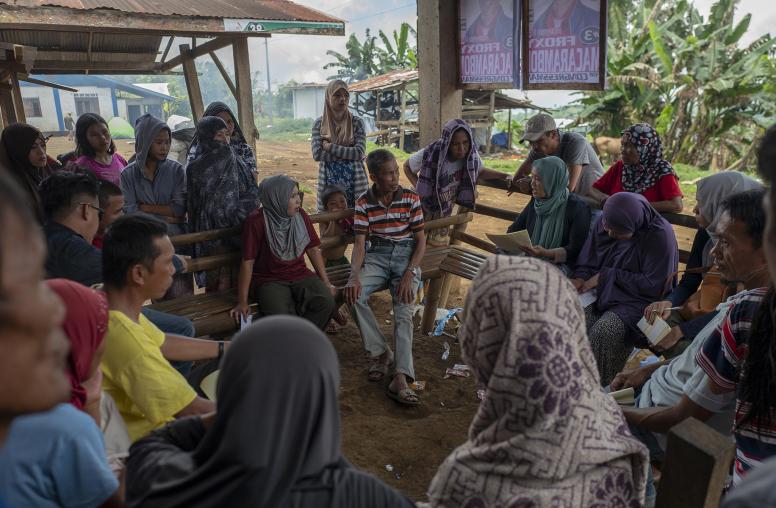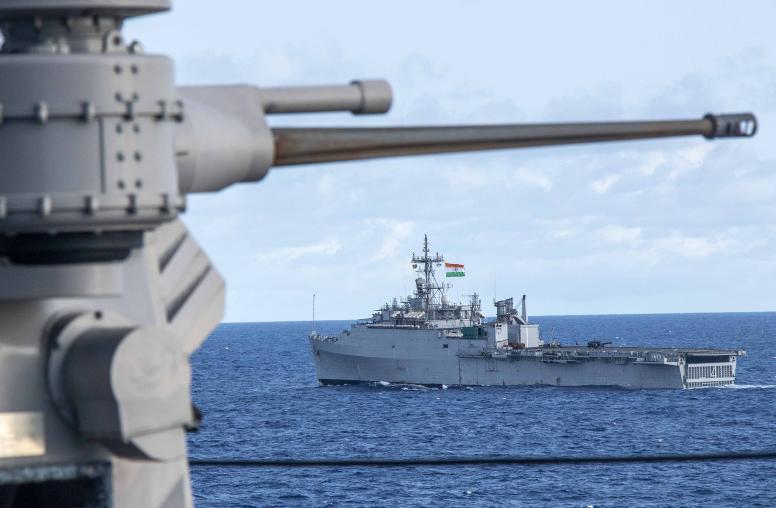Yugoslavia Web Links
Below are links by topical categories to resources primarily in English providing information on funding of democratic initiatives in the Federal Republic of Yugoslavia and the transition to democracy in Serbia. For additional information on the region, please see related links at Regional Resources: Europe.
- General Resources
- Democracy Funding: Recipients
- Democracy Funding: Sources
- Maps and Guides
- Media and News Sources
- Nongovernmental Organizations and Other Political Resources
- Selected Documents and Biographical Information
These links complement these USIP Special Reports:
- "Yugoslavia:" Building Democratic Institutions
- Whither the Bulldozer?: Nonviolent Revolution and the Transition to Democracy in Serbia
- Taking Stock and Looking Forward: Intervention in the Balkans and Beyond
- Serbia Still at the Crossroads
These web links also support the activities of the Institute's Balkans Initiative.
General Resources
The sites below collect links to other Internet resources which describe the background, history, and politics of Yugoslavia.
- Federal Republic of Yugoslavia Official Web Site (FRY)
The official web site of the FRY, it includes links to the flag, maps, federal insitutions, election information, the Constitution of the FRY, email for individual government ministers, the prime minister and the president. The Federal Ministry of Foreign Affairs for the Federal Republic of Yugoslavia web site includes daily bulletins, foreign policy documents, press releases, facts about FRY, Serbia and Montenegro, and links to related sites. - INCORE guide to Internet sources on conflict and ethnicity in Serbia and Montenegro
A selective collection of annotated links to sources for news, articles and documents, non-governmental organizations, maps, etc. from the Initiative on Conflict Resolution & Ethnicity. - International Cultural Center (ICC) Library--Eastern Europe Links: Serbia
From Texas Tech University, annotated links to government, internet search tools (with automatic searches from three search engines), and other useful general resources. - Sources on the Balkan Peninsula: Yugoslavia
A collection of links compiled by the Hellenic Resources Institute and posted on their network, covering news sources, agencies, organizations, political parties, and lists of links from commercial search engines such as Yahoo! and Alta Vista.
Democracy Funding: Recipients
- Association for Independent Electronic Media
Funded by the National Endowment for Democracy, information about the organization is accessed through the Free B92 web site. It contains links to the ANEM Radio Network and the ANEM TV Network. - Internews
The web site contains a description of the organization, news, activities, regional projects, including Southeast Europe, reports, programs and links to related sites including Internews Southeast Europe. "Internews work in Serbia/Montenegro/Kosovo is supported by USAID through a sub-grant from IREX's ProMedia program." - STAR Project of Delphi International
"Under a three year Cooperative Agreement with the U.S. Agency for International Development, the STAR Project builds partnerships with non-nationalistic women's organizations in Bosnia and Herzegovina, Croatia and Macedonia." This web page is a newsletter for the project.
Democracy Funding: Sources
- American Center for International Labor Solidarity (Solidarity Center)
Funded by the National Endowment for Democracy, "the Solidarity Center works to promote the vital role of trade unions in countries making the transition to democracy." The NED web page contains contact information and a brief description of the Center's mission. - Central and East European Law Initiative (CEELI)
A public service project of the American Bar Association "designed to advance the rule of law in the world by supporting the law reform process underway in Central and Eastern Europe and the New Independent States of the former Soviet Union". The web site includes an overview of CEELI programs, assessment of draft legislation, lists of events and links. - Fund for an Open Society Yugoslavia
The web site is in Serbian and English, with descriptions of programs and other activities, as well as links to related web sites of NGOs, and other organiations involved in arts and culture, media, education and human rights. Fund for an Open Society Yugoslavia is part of the Soros Foundations Network and listed as one of many national foundations funded by Soros. - International Foundation for Election Systems (IFES)
A "private, nonprofit organization established in 1987 to support electoral and other democratic institutions in emerging, evolving and experienced democracies." The web site includes a description of project activities, an elections calendar, publications, links to field offices and other web resources, relevant documents, including specific reports on projects in the Federal Republic of Yugoslavia. - International Republican Institute (IRI)
"IRI conducts programs outside the United States to promote democracy and strengthen free markets and the rule of law. The programs are tailored to the needs of pro-democracy activists in over 30 countries and include, for example, grassroots political organizing, campaign management, polling, parliamentary training, judicial reform and election monitoring." The web site includes reports on programs in Central and Eastern Europe and links to other web resources. - National Democratic Institute for International Affairs (NDI)
The web site includes information about the mission of NDI, the new Access Democracy database, relevant reports, statements, descriptions of activities worldwide, detailing programs in the Serbia, Montenegro and Kosovo, and links to other web resources. - National Endowment for Democracy
A "private, nonprofit, grant-making organization created in 1983 to strengthen democratic institutions around the world," the web site includes statements, publications including Journal of Democracy, press releases, links to the grants program, specifically Central and East European grant projects and grantees. Other web resources on democracy include databases, the International Forum for Democratic Studies, the Democracy Resource Center, and the The Democracy Resource Center's 2001 Guide to Sources of Funding in International Democratic Development listing more than 100 organizations that provide funding for democracy projects. - United States Agency for International Development (USAID)
USAID's web site has a section on democracy and governance, with links to its programs, agency objectives, publications and links to other web sites. The web site also includes an outline of resources for Europe and Eurasia, with links to pages for specific countries. Some country pages include information on reports from the Support for East European Democracy (SEED) program, specifically Macedonia and Bulgaria. - United States Department of State: Bureau of Educational and Cultural Affairs
Funded by the Bureau of Educational and Cultural Affairs and administered by the International Research & Exchanges Board (IREX), the Ron Brown Fellowship Program "provides opportunities for graduate study at leading U.S. institutions to outstanding university graduates and young professionals from Central and Eastern Europe." Additionally, the Bureau funds a college and university affiliations program. A database of grantees from the Office of Citizen Exchanges, Europe/Eurasia Division for 2000 and 1992-1999 is available and searchable by organization name and additionally for 2000, by theme funded.
Maps and Guides
- CIA Factbook: Serbia and Montenegro
Basic facts on Serbia and Montenegro prepared by the U.S. Central Intelligence Agency. - Political Map of Serbia
Maps detailing political, ethnic, economic, etc. terrain in Serbia, prepared by the U.S. Central Intelligence Agency. Part of the larger Balkans Regional Atlas, which also covers Bosnia and Herzegovina, Croatia and the Former Yugoslav Republic of Macedonia. - Serbia Maps
Maps from the Perry-Castaneda Library Map Collection of the University of Texas at Austin. These maps were produced by the U.S. Central Intelligence Agency and the Defense Mapping Agency.
Media and News Sources
- B92
Internet, Radio and TV B92 with breaking news from Yugoslavia in English, Serbian, Hungarian and Albanian. Includes links to B92 projects in music and publishing as well as media links to the Association of Independent Electronic Media (ANEM). Requires Real Player for some files. - Free Serbia
In English and Serbian, the web site includes current news, commentary and analysis, interviews, documents, and an extensive set of links to related web sites. - OneWorld.Net: Yugoslavia
News and analysis on Yugoslavia contributed by OneWorld partners, organized in reverse chronology. Includes a keyword search for narrowing search criteria. - Radio Free Europe/Radio Liberty
The Newsline daily reports cover developments in the region: REF/RL Balkan Report contains news from Yugoslavia. Related reports include the RFE/RL Newsline for Southeastern Europe and RFE/RL Newsline for Central and Eastern Europe with links to news broadcasts in four languages. Subscription through e-mail is also available. Keyword searching is also available. - Yahoo News: Full Coverage: Yugoslavia
Extensive selection of news stories, news sources, opinions and editorials, audio and video files, and links to related organizations (advocacy, political and civil) and other web sites.
Nongovernmental Organizations and Other Political Resources
- Center for Free Elections and Democracy (CeSID)
In Serbian and English, the web site contains information about the organization, regional offices, contacts, recent elections, current news, and publications, including one on Guide through Electoral Controversies in Serbia in PDF (requires Adobe® Acrobat® Reader to view) - Elections Around the World: Yugoslavia
Web site includes statistical information on elections in Yugoslavia and links to political parties with web sites. - G17 PLUS
In Serbian and English, the web site includes a description of the organization as "an expert network for helping the citizens of Serbia," its goals and activities, press releases, speeches, conference reports and other documents, with links to the G17 Institute and related web sites. - Otpor!
Web site, in English, of the Student Resistance Movement contains background information about the organization, a news archive, documents, international press articles, actions by Otpor!, abstracts and some full text of articles on the history of student protests in Yugoslavia, artwork and links to related web sites including Otpor! in Serbian. - Political Resources on the Net: Federal Republic of Yugoslavia (Serbia and Montenegro)
Several links to three categories of web sites: political parties and organizations (including opposition parties in Yugoslavia), governmental agencies and media sources. - Task Force on the Future of the Federal Republic of Yugoslavia
Part of the Bratislava process, which began with a 1999 conference cosponsored by the EastWest Institute and Slovakian Ministry of Foreign Affairs, the task force includes on its web site analytical briefs, speeches, conference reports, news, and links to related web sites. Mailing list subscription for e-mail or fax delivery of documents is available.
Selected Documents and Biographical Information
- Gene Sharp
On the web site of the Canadian Centres for Teaching Peace is biographical information on Gene Sharp, a senior scholar at the Albert Einstein Institution and the author of The Politics of Nonviolent Action and From Dictatorship to Democracy: a Conceptual Framework for Liberation. Also includes a list of his selected publications. - General Framework Agreement for Peace in Bosnia and Herzegovina
Full text of the Dayton Peace Agreement, ending hostilities, calling for a just and durable peace, and promoting reconstruction and reconciliation. Part of the U.S. Institute of Peace Library's Peace Agreements Digital Collection. - Salon News | Milosevic's media blackout
Written by Laura Rozen, Salon's correspondent on the Balkans crisis, and dated May 18, 2000.
http://www.salon.com/news/feature/2000/05/18/milosevic/index.html (August 13, 1999). - Yugoslavia, Federal Republic of: Country Reports on Human Rights Practices: 2001
The U.S. State Department's extensive report on human rights in the Federal Republic of Yugoslavia, released by the Bureau of Democracy, Human Rights, and Labor, March 4, 2002. Reports for 2000 and previous years 1993-1999 are available online.
Updated: June 18 2002




